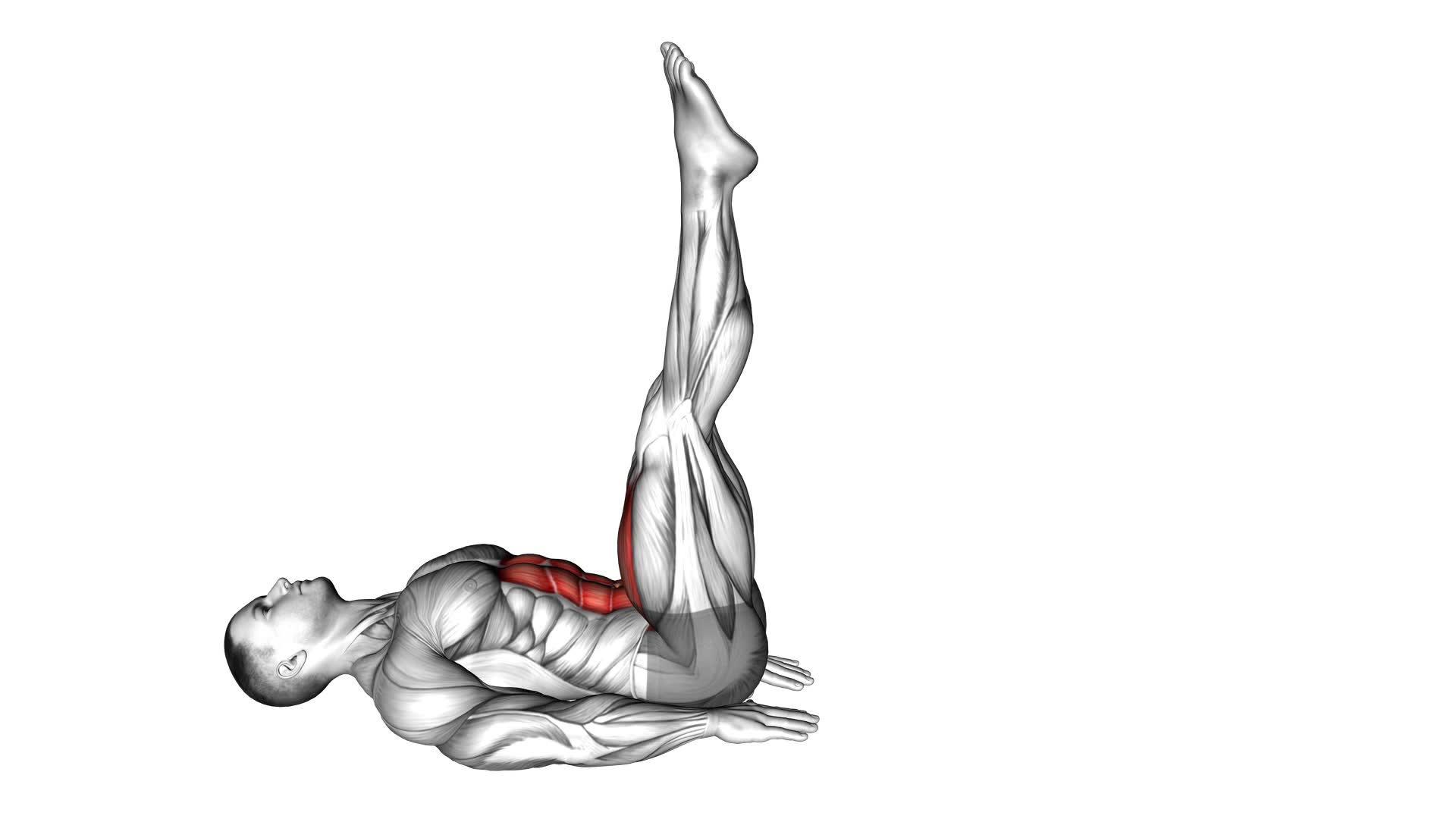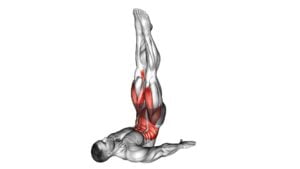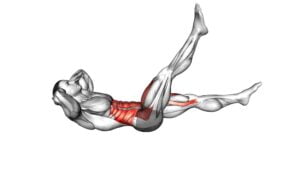Alternate Leg Raise (male) – Video Exercise Guide & Tips

Are you looking for a challenging lower body exercise? Look no further than the alternate leg raise.
Watch This Exercise Video
In this video exercise guide, we'll show you the proper form to maximize your results. Avoid common mistakes and learn tips for increasing the intensity.
Whether you're a beginner or experienced, we've got modifications to suit your fitness level. Get ready to reap the benefits of this effective exercise.
Let's get started!
Key Takeaways
- Engage your core throughout the movement to protect your lower back.
- Limit the height of the lift by your hip flexibility.
- Maintain control and stability as you raise one leg off the ground.
- Lifting your legs too high can strain your lower back.
Proper Form for Alternate Leg Raise
To perform the alternate leg raise exercise correctly, you should start by lying on your back with both legs straight and flat on the ground.
This exercise is often misunderstood, so it's important to clear up some common misconceptions. First, make sure to keep your core engaged throughout the movement to protect your lower back.
Many people mistakenly believe that lifting the legs as high as possible is the goal, but in reality, the height of the lift should be limited by your hip flexibility.
Focus on maintaining control and stability as you raise one leg off the ground, keeping the other leg straight and pressing it into the floor. As you lower one leg, the other leg should remain in the starting position.
Remember to breathe deeply and avoid holding your breath during the exercise.
Variations of the alternate leg raise include adding ankle weights or performing the exercise on an incline bench to increase the challenge.
Progressions can be made by increasing the number of repetitions or slowing down the tempo of the movement.
Keep in mind that proper form and technique should always be prioritized over intensity.
Common Mistakes to Avoid
Now let's delve into some common mistakes that you should avoid while performing the alternate leg raise exercise.
Proper technique is crucial to maximize the effectiveness of this exercise and prevent injury.
One common mistake is lifting your legs too high. While it may seem like a greater range of motion will yield better results, raising your legs too high can strain your lower back and diminish the effectiveness of the exercise.
Another mistake to watch out for is rushing through the movement. It's important to maintain control and perform the exercise slowly and deliberately. This allows you to engage your core muscles properly and get the most out of each repetition.
Additionally, avoid swinging your legs or using momentum to lift them. This cheats your muscles out of the work they should be doing and reduces the effectiveness of the exercise.
Lastly, remember to keep your lower back pressed firmly against the mat or floor throughout the movement. Arching your back can lead to discomfort and potential injury.
Tips for Increasing Intensity
To increase the intensity of the alternate leg raise exercise, try incorporating weighted ankle cuffs or holding a dumbbell between your feet. These additional challenges will help you push your limits and take your workout to the next level.
Here are four ways to challenge yourself and add variations for advanced individuals:
- Increase the weight: Gradually increase the weight of the ankle cuffs or dumbbell to make the exercise more challenging. Start with a lighter weight and gradually work your way up as you get stronger.
- Slow down the movement: Instead of performing the leg raises quickly, focus on controlling the movement and performing it at a slower pace. This will engage your muscles for a longer duration and increase the intensity.
- Add pauses at the top: When you lift your legs, hold them at the top of the movement for a few seconds before lowering them back down. This will increase the time under tension and make the exercise more challenging.
- Incorporate other exercises: Combine the alternate leg raise with other exercises, such as planks or Russian twists, to create a more advanced workout routine. This will engage multiple muscle groups and provide a greater overall challenge.
Modifications for Beginners
If you're a beginner, you can modify the alternate leg raise exercise to suit your fitness level and gradually increase the intensity. Making modifications is essential to ensure that you're performing the exercise correctly and avoiding any potential injuries. Here are some beginner modifications you can incorporate into your alternate leg raise routine.
Firstly, instead of lifting both legs off the ground simultaneously, you can start by lifting one leg at a time. This modification allows you to focus on maintaining proper form and engaging your core muscles effectively. As you build strength and confidence, you can progress to lifting both legs together.
Additionally, if raising your legs straight up is too challenging, you can slightly bend your knees while performing the exercise. This modification reduces the strain on your lower back and makes it easier to lift your legs.
Another modification for beginners is to perform the alternate leg raise exercise with your hands supporting your lower back. By placing your hands under your glutes, you provide extra support and stability, especially if your core muscles aren't yet strong enough.
Remember to listen to your body and progress at a pace that feels comfortable for you. As you become more proficient, you can gradually decrease the modifications and challenge yourself with the full alternate leg raise exercise.
Benefits of Alternate Leg Raise
As a beginner, incorporating modifications into your alternate leg raise routine can help you gradually increase the intensity and reap the benefits of this exercise. Here are some advantages and variations to consider:
- Strengthening the core: Alternate leg raises primarily target the abdominal muscles, helping to strengthen and tone your core. This can improve your posture, stability, and overall functional fitness.
- Improving hip flexibility: By raising one leg at a time, you engage the hip flexors, which can improve their flexibility and range of motion. This can be particularly beneficial for athletes and individuals who participate in activities that require hip mobility.
- Enhancing balance and coordination: The alternating movement of lifting one leg while keeping the other grounded challenges your balance and coordination. Regular practice can improve your stability and body control, reducing the risk of falls and injuries.
- Variations for added challenge: Once you have mastered the basic alternate leg raise, you can try variations such as lifting both legs simultaneously, adding ankle weights, or performing the exercise on an unstable surface like a balance board or BOSU ball. These variations increase the difficulty and further engage your core muscles.
Incorporating alternate leg raises into your fitness routine can provide numerous benefits, including core strength, improved hip flexibility, enhanced balance, and coordination. Experiment with different variations to keep your workouts challenging and exciting.
Frequently Asked Questions
How Many Sets and Reps Should I Perform for the Alternate Leg Raise Exercise?
To burn calories and activate your muscles effectively, you need to perform the alternate leg raise exercise with the right sets and reps.
Without the context of the specific exercise, it's difficult to give you an exact answer. However, a general guideline is to start with 2-3 sets of 10-15 reps.
Remember to listen to your body and gradually increase the intensity as you get stronger.
Is It Normal to Feel Lower Back Pain During the Alternate Leg Raise Exercise?
Yes, it's normal to feel lower back pain during the alternate leg raise exercise if you aren't using proper form and technique.
It's important to maintain a neutral spine and engage your core muscles throughout the exercise.
Common mistakes to avoid include arching your back, lifting your legs too high, and using momentum to swing your legs.
Focus on controlled movements and start with a range of motion that feels comfortable for you.
Can the Alternate Leg Raise Exercise Help Improve My Balance and Stability?
Improving your balance and stability is one of the benefits of the alternate leg raise exercise. By engaging your hip muscles, this exercise helps strengthen them, which can lead to better coordination and stability.
It's normal to feel some challenge and fatigue during this exercise, but if you experience any pain, it's important to stop and consult a professional.
Remember to maintain proper form and gradually increase the intensity of the exercise for optimal results.
Should I Use Ankle Weights or Resistance Bands to Increase the Intensity of the Alternate Leg Raise Exercise?
To increase the intensity of the alternate leg raise exercise, you can consider using ankle weights or resistance bands.
Both options have their benefits. Ankle weights add extra resistance to your legs, challenging your muscles and improving strength.
On the other hand, resistance bands provide a different type of resistance, helping to improve stability and control.
Ultimately, the choice between ankle weights and resistance bands depends on your preference and fitness goals.
Can the Alternate Leg Raise Exercise Help in Reducing Belly Fat or Toning the Abdominal Muscles?
The alternate leg raise exercise is a great addition to your workout routine for overall body toning. It targets your abdominal muscles and can help reduce belly fat when combined with a healthy diet.
To maximize results, incorporate the alternate leg raise exercise into a comprehensive workout routine that includes cardio, strength training, and flexibility exercises. This will ensure that you're working all muscle groups and achieving maximum benefits.
Keep up the good work!
Conclusion
In conclusion, the alternate leg raise is a beneficial exercise for improving core strength and stability. By following proper form and avoiding common mistakes, you can effectively target your abdominal muscles.
To increase intensity, you can add weight or perform the exercise on an unstable surface. Beginners can modify the exercise by bending their knees or performing the exercise with one leg at a time.
Incorporating alternate leg raises into your workout routine can lead to improved balance, posture, and overall fitness.

Author
Years ago, the spark of my life’s passion ignited in my mind the moment I stepped into the local gym for the first time. The inaugural bead of perspiration, the initial endeavor, the very first surge of endorphins, and a sense of pride that washed over me post-workout marked the beginning of my deep-seated interest in strength sports, fitness, and sports nutrition. This very curiosity blossomed rapidly into a profound fascination, propelling me to earn a Master’s degree in Physical Education from the Academy of Physical Education in Krakow, followed by a Sports Manager diploma from the Jagiellonian University. My journey of growth led me to gain more specialized qualifications, such as being a certified personal trainer with a focus on sports dietetics, a lifeguard, and an instructor for wellness and corrective gymnastics. Theoretical knowledge paired seamlessly with practical experience, reinforcing my belief that the transformation of individuals under my guidance was also a reflection of my personal growth. This belief holds true even today. Each day, I strive to push the boundaries and explore new realms. These realms gently elevate me to greater heights. The unique combination of passion for my field and the continuous quest for growth fuels my drive to break new ground.







